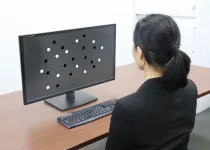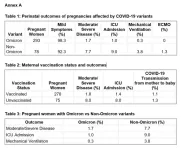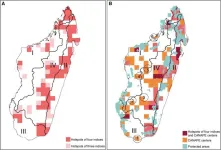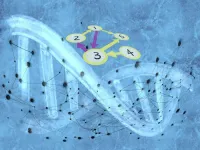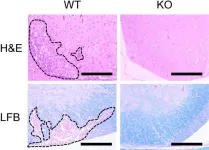(Press-News.org) When we recycle electronic devices we can no longer use, we expect to make the most out of the precious natural resources that went into building them. But electronic waste is notoriously difficult to recycle, because it’s hard to separate the different metals in the waste from each other. Scientists have now found a way of selectively capturing metals from a waste stream using spent brewer’s yeast, the same beer byproduct that goes into Marmite. Not only that: the yeast can be reused, making the process even more eco-friendly.
“Electronic waste is difficult to recycle because it is very heterogeneous,” said Dr Klemens Kremser of the University of Natural Resources and Life Sciences, Vienna, corresponding author of the article in Frontiers in Bioengineering and Biotechnology. “Getting the metals in solution is a first step, but the selective recovery of the metals remains a challenge. Compared to processes such as chemical precipitation, biosorption using spent brewer’s yeast presents a cheap and environmentally friendly approach.”
Love it or hate it?
Several options already exist for separating out the different component metals of electronic waste, including other biosorbents — biological materials which can be used to soak up pollution. However, they all have significant downsides. For instance, chemical precipitation produces contaminated slag, while biochar — a biosorbent which is similar to charcoal — is difficult to separate from wastewater.
So the scientists turned to brewer’s yeast. Because leftover brewer’s yeast is a common byproduct of beer-brewing, it’s cheap and widely available. This research was supported by COMET (Competence Center for Excellent Technologies), the Austrian program for competence centers.
The scientists acquired 20 liters of spent brewer’s yeast, separated the biomass from leftover brewing residues, and dried out the biomass. Electrostatic interactions on the surface of the yeast allow metal ions to stick to that surface — a process called adsorption. Changing the pH of this solution alters the interactions, which can allow the yeast to adsorb more or different metal ions, depending on the contents of the solution and the specific pH.
The scientists chose to test the yeast biomass against zinc, aluminum, copper, and nickel, economically important metals. The scientists tested each metal solution at a range of different pHs and temperatures, to gauge whether it was possible to increase the strength of the interactions and recover more metal. The scientists also tested the yeast against a real polymetallic waste stream.
“Using waste biomass for metal recovery is not a completely new process, but the selectivity of biosorption processes is a key factor for efficient metal recovery from polymetallic waste streams,” said Anna Sieber, PhD fellow of K1-MET, an Austrian metallurgical research center, and first author of the article. “We demonstrated high metal recovery rates from a complex metal solution using an environmentally friendly and cheap biomass. Yeast biomass is considered a safe organism, and the demonstrated reusability of the biomass makes it an economically feasible approach.”
Reduce, reuse, recycle
The scientists were able to recover more than 50% of aluminum, more than 40% of copper, and more than 70% of zinc from the test metal solutions. Over 50% of copper and over 90% of zinc were retrieved from the polymetallic waste stream they tested the yeast on.
Changing the temperature had relatively little impact on efficiency, except for zinc, where it raised the recovery rate by 7.6%. Similarly, adjusting the pH had a limited effect on most of the metal solutions, except for aluminum, where it improved the efficiency of recovery by 16%.
“The metals can be removed from the yeast surface by acid treatment and thus could be recycled,” said Sieber. “It would be interesting to investigate potential applications for these reclaimed metals.”
The yeast itself could also be recycled without heavily impacting its ability to recover metal: the scientists were able to use it five times to recover different metals.
However, the scientists caution that the metal recovery process needs testing with much larger studies in real-life conditions before it can be implemented on an industrial scale.
“The metal removal process in this study was optimized for the four metals in question,” said Kremser. “The concentration of potentially interfering metal ions was very low in our starting solutions, but this would be important to consider when applying this approach to different mixed metal solutions.”
END
Beer byproduct behind Marmite could help us recycle metal waste
Scientists use spent brewer’s yeast, left over from manufacturing beer, to filter out metal from waste streams
2024-03-12
ELSE PRESS RELEASES FROM THIS DATE:
Guessing game: Response may bias understanding of future scenarios
2024-03-12
Does previous experience bias a person in future estimations? Yes, Osaka Metropolitan University researchers in Japan report, but only if the person engages higher processing powers by responding, as opposed to simply observing.
They made their findings through experiments involving participants estimating the number of dots flashed on a screen. Participants either had to input their estimate before making another estimate on a new set of dots or were not prompted to do anything but observe. The researchers found ...
KKH-led study reveals low COVID-19 transmission rate from mothers to newborns
2024-03-12
11 March 2024, Singapore – A study[1] by KK Women’s and Children’s Hospital (KKH), Singapore General Hospital (SGH) and National University Hospital (NUH) has revealed that COVID-19 transmission from mothers to their newborns is low.
The study involving 371 women who had COVID-19 infection during pregnancy and their newborns found that only four infants or 1.1 per cent of the babies were diagnosed with COVID-19 after birth, of which three (1.1 per cent) were from mothers who were COVID-19 vaccinated and one infant (1.3 per cent) was from a mother who was not vaccinated.
Senior Author of the study, Dr Yeo Kee Thai, Senior Consultant, Department of Neonatology, KKH ...
Scientists identify biodiversity conservation gaps in Madagascar
2024-03-12
Despite the importance of biodiversity and the urgency to conserve it, assessing what aspect of biodiversity requires the highest priority has proven complex, especially when conservation resources are limited. A new study published in Current Biology sheds light on this question.
Prof. CHEN Zhiduan's team from the Institute of Botany of the Chinese Academy of Sciences (IBCAS) and international collaborators have identified the spatial heterogeneity of biodiversity hotspots and endemism centers. With ...
Sting operation out of gas
2024-03-12
Kyoto, Japan -- Cells possess an innate immune system that defends against invasive pathogens such as bacteria and viruses. Previous studies have mapped out the cytoplasmic cGAS-STING pathway in the cytoplasm, known for responding to foreign nucleic acids, such as double-stranded DNA.
Micronuclei -- or MN, abnormal intracellular structures containing the cell's DNA -- have also been suspected of triggering the pathway. However, no conclusive evidence exists of pathway activation by MN-induced cyclic GMP-AMP synthase, or cGAS.
Now, Kyoto University and the AIRC Institute of Molecular Oncology, or IFOM, have ...
Have metalenses expanded their reach into the ultraviolet region?
2024-03-12
Ultraviolet rays find diverse applications in medical and healthcare, serving purposes such as disinfection, sterilization, and therapy. They are also used in the semiconductor industry for creating microcircuits and patterns. A metalens fabrication process, developed by a team of researchers at Pohang University of Science and Technology (POSTECH), enables control over the optical properties of these UV rays. This innovation has garnered significant attention across industries, sparking interest in potential advancements.
A collaborative research team, comprising Professor Junsuk Rho from the Department of Mechanical Engineering and the Department of Chemical Engineering ...
Key protein linked to immune disorders
2024-03-12
A new study highlights a potential therapeutic target for immune-related disorders, such as multiple sclerosis and asthma.
A new study has shed light on the importance of the protein STAP-1 in activating certain immune cells. Understanding the role of STAP-1 in these cells could give researchers a better glimpse into immune-related disorders and ways to treat them.
The researchers found that STAP-1 plays an important role in the activation of T cells, which are white blood cells that play a critical role in defending the body against infections and maintaining overall health. T cells are adept at recognizing foreign molecules that ...
COVID-19 had greater impact on life expectancy than previously known, but child mortality rates continued to decline during the pandemic
2024-03-12
**Embargo: 23:30 UK, 7:30 p.m. ET March 11, 2024**
***Please note the unusual embargo time for the United States due to daylight savings time***
Global Burden of Disease
COVID-19 had greater impact on life expectancy than previously known,
but child mortality rates continued to decline during the pandemic
A new study published in The Lancet reveals never-before-seen details about staggeringly high mortality from the COVID-19 pandemic within and across countries. Places such as Mexico City, Peru, and Bolivia had some of the largest drops in life expectancy from 2019 to 2021. The research, which presents updated ...
NSF CAREER Grant awarded to Dr. Jordon Gilmore Associate Professor of Bioengineering Clemson University
2024-03-12
Congratulations to Dr. Jordon Gilmore for receiving the prestigious NSF CAREER Award! The project is titled: "A Multi-phase Biosensing Approach towards Point-of-Care Evaluation of Pseudomonas aeruginosa Virulence in Infected Chronic Wounds". The project is in perfect alignment with the ADAPT in SC NSF Award. Dr. Gilmore is a co-leader of the the Explainable AI-Enabled Biomedical Devices for Diagnostics and Planning Applications, and the leader of the Broadening Participation and Diversity project areas of ADAPT in SC. In addition, he serves as a member of the ...
How do neural networks learn? A mathematical formula explains how they detect relevant patterns
2024-03-12
Neural networks have been powering breakthroughs in artificial intelligence, including the large language models that are now being used in a wide range of applications, from finance, to human resources to healthcare. But these networks remain a black box whose inner workings engineers and scientists struggle to understand. Now, a team led by data and computer scientists at the University of California San Diego has given neural networks the equivalent of an X-ray to uncover how they actually learn.
The researchers found that a formula used in statistical analysis provides a streamlined mathematical description of how neural networks, such as GPT-2, a precursor ...
Vaccine monitoring crucial as SARS-CoV-2 variants continue to evolve
2024-03-12
Researchers at the Francis Crick Institute and the National Institute for Health and Care Research Biomedical Research Centre at UCLH have highlighted the importance of continued surveillance of emerging SARS-CoV-2 variants and vaccine performance as the virus continues to evolve.
Published today as a research letter in The Lancet, their study compared the newer monovalent COVID vaccine, which specifically targets the XBB variant of Omicron (as recommended by the World Health Organisation), with older bivalent vaccines containing a mix of an Omicron variant and the original strain of COVID-19, which ...
LAST 30 PRESS RELEASES:
University of Oklahoma researcher awarded funding to pursue AI-powered material design
Exploring how the visual system recovers following injury
Support for parents with infants at pediatric check-ups leads to better reading and math skills in elementary school
Kids’ behavioral health is a growing share of family health costs
Day & night: Cancer disrupts the brain’s natural rhythm
COVID-19 vaccination significantly reduces risk to pregnant women and baby
The role of vaccination in maternal and perinatal outcomes associated with COVID-19 in pregnancy
Mayo Clinic smartwatch system helps parents shorten and defuse children's severe tantrums early
Behavioral health spending spikes to 40% of all children’s health expenditures, nearly doubling in a decade
Digital cognitive behavioral treatment for generalized anxiety disorder
Expenditures for pediatric behavioral health care over time and estimated family financial burden
Air conditioning in nursing homes and mortality during extreme heat
The Alps to lose a record number of glaciers in the next decade
What makes a good proton conductor?
New science reporting guide published for journalists in Bulgaria
New international study reveals major survival gaps among children with cancer
New science reporting guide published for journalists in Turkey
Scientists develop a smarter mRNA therapy that knows which cells to target
Neuroanatomy-informed brain–machine hybrid intelligence for robust acoustic target detection
Eight SwRI hydrogen projects funded by ENERGYWERX
The Lundquist Institute and its start-up company Vitalex Biosciences Announces Strategic Advancement of Second-Generation fungal Vaccine VXV-01 through Phase 1 Trials under $40 Million Competitive Con
Fine particles in pollution are associated with early signs of autoimmune disease
Review article | Towards a Global Ground-Based Earth Observatory (GGBEO): Leveraging existing systems and networks
Penn and UMich create world’s smallest programmable, autonomous robots
Cleveland researchers launch first major study to address ‘hidden performance killer’ in athletes
To connect across politics, try saying what you oppose
Modulating key interaction prevents virus from entering cells
Project explores barriers to NHS career progression facing international medical graduates
Jeonbuk National University researchers explore the impact of different seasonings on the flavor perception of Doenjang soup
Two Keck Medicine of USC Hospitals named Leapfrog Top Teaching Hospitals
[Press-News.org] Beer byproduct behind Marmite could help us recycle metal wasteScientists use spent brewer’s yeast, left over from manufacturing beer, to filter out metal from waste streams
